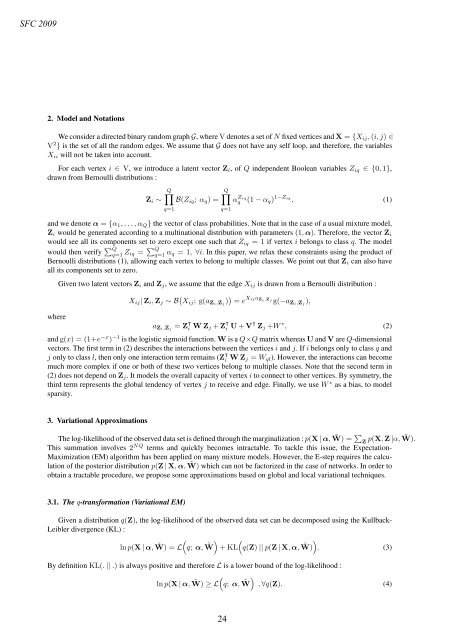Actes - Société Francophone de Classification
Actes - Société Francophone de Classification
Actes - Société Francophone de Classification
Create successful ePaper yourself
Turn your PDF publications into a flip-book with our unique Google optimized e-Paper software.
SFC 2009<br />
2. Mo<strong>de</strong>l and Notations<br />
We consi<strong>de</strong>r a directed binary random graph G, where V <strong>de</strong>notes a set of N fixed vertices and X = {Xij, (i, j) ∈<br />
V 2 } is the set of all the random edges. We assume that G does not have any self loop, and therefore, the variables<br />
Xii will not be taken into account.<br />
For each vertex i ∈ V, we introduce a latent vector Zi, of Q in<strong>de</strong>pen<strong>de</strong>nt Boolean variables Ziq ∈ {0, 1},<br />
drawn from Bernoulli distributions :<br />
Zi ∼<br />
Q�<br />
B(Ziq; αq) =<br />
q=1<br />
Q�<br />
q=1<br />
α Ziq<br />
q (1 − αq) 1−Ziq , (1)<br />
and we <strong>de</strong>note α = {α1, . . . , αQ} the vector of class probabilities. Note that in the case of a usual mixture mo<strong>de</strong>l,<br />
Zi would be generated according to a multinational distribution with parameters (1, α). Therefore, the vector Zi<br />
would see all its components set to zero except one such that Ziq =1if vertex i belongs to class q. The mo<strong>de</strong>l<br />
would then verify �Q q=1 Ziq = �Q q=1 αq =1, ∀i. In this paper, we relax these constraints using the product of<br />
Bernoulli distributions (1), allowing each vertex to belong to multiple classes. We point out that Zi can also have<br />
all its components set to zero.<br />
where<br />
Given two latent vectors Zi and Zj, we assume that the edge Xij is drawn from a Bernoulli distribution :<br />
Xij| Zi, Zj ∼ B � Xij; g(aZi,Zj ) � = e XijaZ i ,Z j g(−aZi,Zj ),<br />
aZi,Zj<br />
= Z⊺<br />
i WZj + Z ⊺<br />
i U + V⊺ Zj +W ∗ , (2)<br />
and g(x) = (1+e−x ) −1 is the logistic sigmoid function. W is a Q×Q matrix whereas U and V are Q-dimensional<br />
vectors. The first term in (2) <strong>de</strong>scribes the interactions between the vertices i and j. If i belongs only to class q and<br />
j only to class l, then only one interaction term remains (Z ⊺<br />
i WZj = Wql). However, the interactions can become<br />
much more complex if one or both of these two vertices belong to multiple classes. Note that the second term in<br />
(2) does not <strong>de</strong>pend on Zj. It mo<strong>de</strong>ls the overall capacity of vertex i to connect to other vertices. By symmetry, the<br />
third term represents the global ten<strong>de</strong>ncy of vertex j to receive and edge. Finally, we use W ∗ as a bias, to mo<strong>de</strong>l<br />
sparsity.<br />
3. Variational Approximations<br />
The log-likelihood of the observed data set is <strong>de</strong>fined through the marginalization : p(X | α, ˜ W)= �<br />
Z p(X, Z |α, ˜ W).<br />
This summation involves 2 NQ terms and quickly becomes intractable. To tackle this issue, the Expectation-<br />
Maximization (EM) algorithm has been applied on many mixture mo<strong>de</strong>ls. However, the E-step requires the calculation<br />
of the posterior distribution p(Z | X, α, ˜ W) which can not be factorized in the case of networks. In or<strong>de</strong>r to<br />
obtain a tractable procedure, we propose some approximations based on global and local variational techniques.<br />
3.1. The q-transformation (Variational EM)<br />
Given a distribution q(Z), the log-likelihood of the observed data set can be <strong>de</strong>composed using the Kullback-<br />
Leibler divergence (KL) :<br />
ln p(X | α, ˜ �<br />
W)=L q; α, ˜ � �<br />
W + KL q(Z) || p(Z | X, α, ˜ �<br />
W) . (3)<br />
By <strong>de</strong>finition KL(. || .) is always positive and therefore L is a lower bound of the log-likelihood :<br />
ln p(X | α, ˜ �<br />
W) ≥ L q; α, ˜ �<br />
W , ∀q(Z). (4)<br />
24


